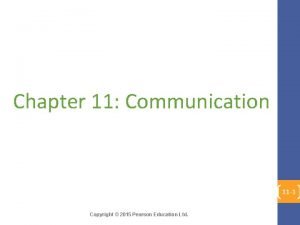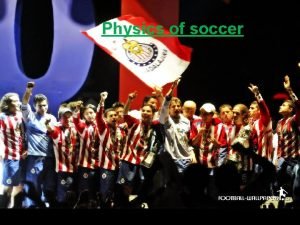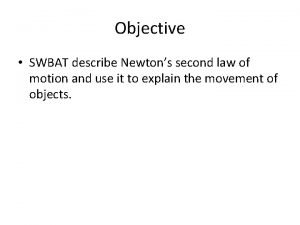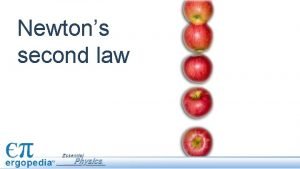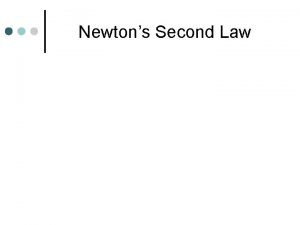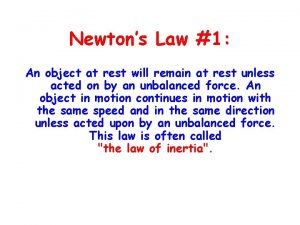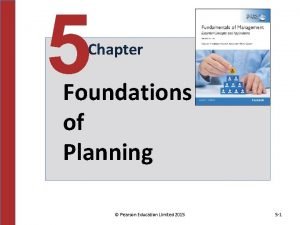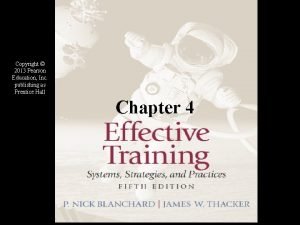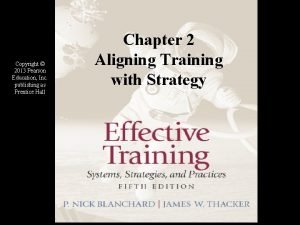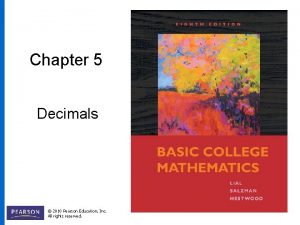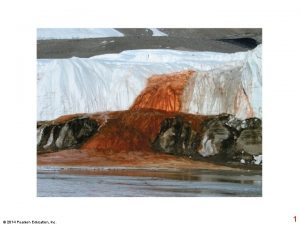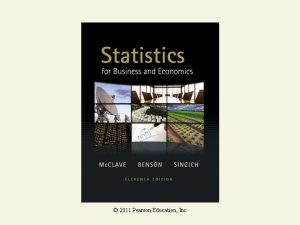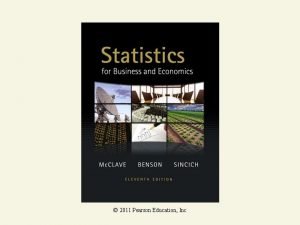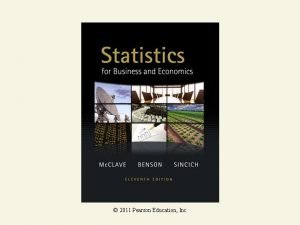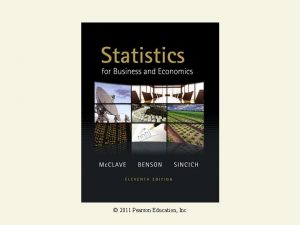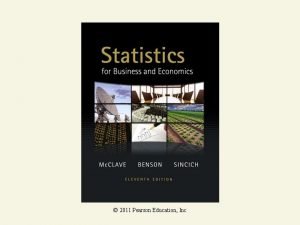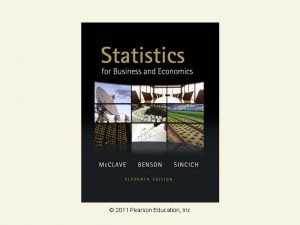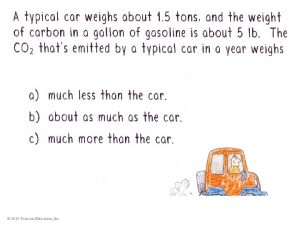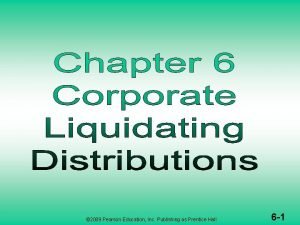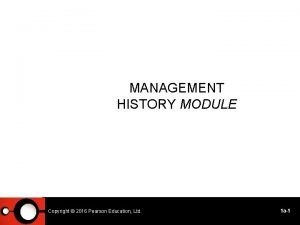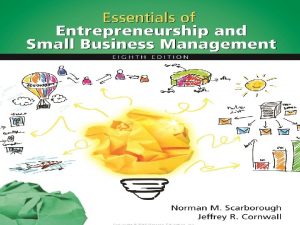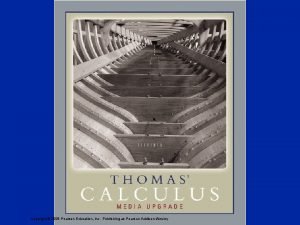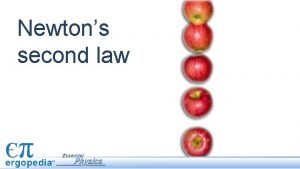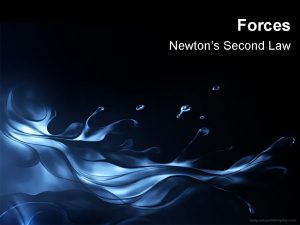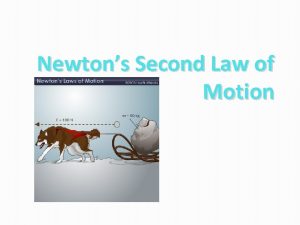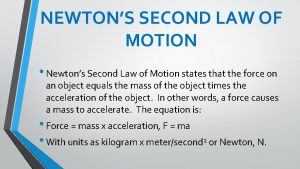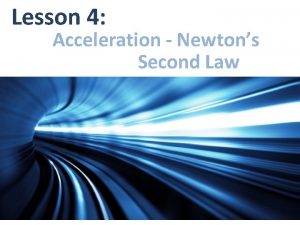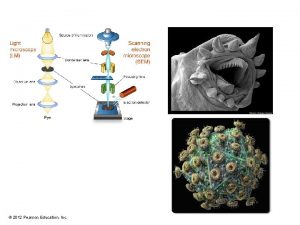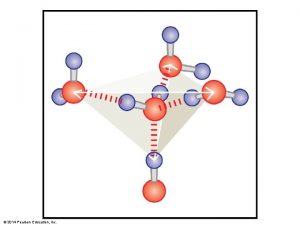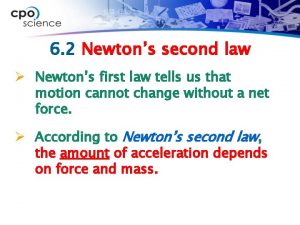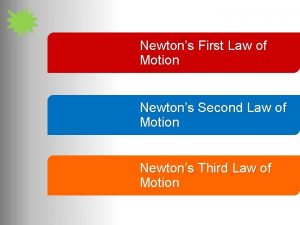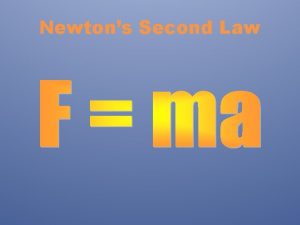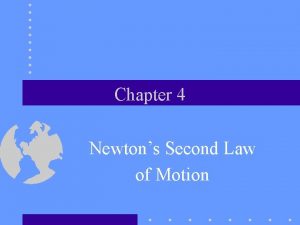Newtons Second Law 2015 Pearson Education Inc Newtons


















































































- Slides: 82

Newton’s Second Law © 2015 Pearson Education, Inc.

Newton’s Second Law • A force causes an object to accelerate. • The acceleration a is directly proportional to the force F and inversely proportional to the mass m: • The direction of the acceleration is the same as the direction of the force: © 2015 Pearson Education, Inc. Slide 4 -2

Newton’s Second Law © 2015 Pearson Education, Inc. Slide 4 -3

Newton’s Second Law (Written with the Σ) • The acceleration of an object is directly proportional to the net force acting on it and inversely proportional to its mass. Section 4. 3 Slide 4 -4

Solving Newton’s Second Law Problems • Read the problem at least once • Draw a picture of the system – Identify the object of primary interest – Indicate forces with arrows • Label each force – Use labels that bring to mind the physical quantity involved Section 4. 5

Solving Newton’s Second Law Problems, cont • Draw a free body diagram – If additional objects are involved, draw separate free body diagrams for each object – Choose a convenient coordinate system for each object • Apply Newton’s Second Law – The x- and y-components should be taken from the vector equation and written separately • Solve for the unknown(s) Section 4. 5

Equilibrium • An object either at rest or moving with a constant velocity is said to be in equilibrium • The net force acting on the object is zero (since the acceleration is zero) Section 4. 5

Equilibrium cont. • Easier to work with the equation in terms of its components: • This could be extended to three dimensions • A zero net force does not mean the object is not moving, but that it is not accelerating Section 4. 5

Equilibrium Example – Free Body Diagrams Section 4. 5

Inclined Planes • Choose the coordinate system with x along the incline and y perpendicular to the incline • Replace the force of gravity with its components Section 4. 5

Multiple Objects – Example • When you have more than one object, the problem-solving strategy is applied to each object • Draw free body diagrams for each object • Apply Newton’s Laws to each object • Solve the equations Section 4. 5

Multiple Objects – Example, cont. Section 4. 5

Some Notes About Forces • Forces cause changes in motion – Motion can occur in the absence of forces • All the forces acting on an object are added as vectors to find the net force acting on the object – m is not a force itself • Newton’s Second Law is a vector equation • Next 4 Slides Review of the relationships between mass/ inertia Force/mass/acceleration Section 4. 3

Exercise, Newton’s 2 nd Law A woman is straining to lift a large crate, without success. It is too heavy. We denote the forces on the crate as follows: P is the upward force being exerted on the crate by the person C is the contact force on the crate by the floor, and W is the weight (force of the earth on the crate). Which of following relationships between these forces is true, while the person is trying unsuccessfully to lift the crate? (Note: force up is positive & down is negative) A. B. C. D. P + C < W P+C>W P=C P+C=W Physics 207: Lecture 6, Pg 14

Mass We have an idea of what mass is from everyday life. l In physics: v Mass is a quantity that specifies how much inertia an object has (i. e. a scalar that relates force to acceleration) (Newton’s Second Law F=ma or a=F/m) l Mass is an inherent property of an object. l Mass and weight are different quantities; weight is usually the magnitude of a gravitational (non-contact) force. l Physics 207: Lecture 6, Pg 15

Inertia and Mass |a| l l l Mass is an inherent property of an object m Mass is independent of the object’s surroundings Mass is independent of the method used to measure it Mass is a scalar quantity The SI unit of mass is kg Physics 207: Lecture 6, Pg 16

Exercise Newton’s 2 nd Law l An object is moving to the right, and experiencing a net force that is directed to the right. The magnitude of the force is decreasing with time (read this text carefully). l The speed of the object is A. B. C. D. increasing decreasing constant in time Not enough information to decide Physics 207: Lecture 6, Pg 17

Question 1 A constant force causes an object to accelerate at 4 m/s 2. What is the acceleration of an object with twice the mass that experiences the same force? A. B. C. D. E. 1 m/s 2 2 m/s 2 4 m/s 2 8 m/s 2 16 m/s 2 © 2015 Pearson Education, Inc. Slide 4 -18

Question 1 A constant force causes an object to accelerate at 4 m/s 2. What is the acceleration of an object with twice the mass that experiences the same force? A. B. C. D. E. 1 m/s 2 2 m/s 2 4 m/s 2 8 m/s 2 16 m/s 2 © 2015 Pearson Education, Inc. Slide 4 -19

Newton’s Third Law © 2015 Pearson Education, Inc.

Newton’s Law 1: An object subject to no external forces is at rest or moves with a constant velocity if viewed from an inertial reference frame. Law 2: For any object, FNET = F = ma Law 3: Forces occur in pairs: FA , B = - FB , A (For every action there is an equal and opposite reaction. ) Read: Force of B on A Physics 207: Lecture 8, Pg 21

Newton’s Third Law: If object 1 exerts a force on object 2 (F 2, 1 ) then object 2 exerts an equal and opposite force on object 1 (F 1, 2) F 1, 2 = -F 2, 1 For every “action” there is an equal and opposite “reaction” IMPORTANT: Newton’s 3 rd law concerns force pairs which act on two different objects (not on the same object) ! Physics 207: Lecture 8, Pg 22

Push Me and I Push Back!!! Physics 207: Lecture 8, Pg 23

Push me and I push back! For example, with the palm of your hand, push on a book, desk or table. You are exerting a force on the object you are pushing. At the same time, you can feel a force on your hand. There seems to be two forces: the one your hand exerted on the object, and another force on your hand. l What is the relationship between these forces? l Physics 207: Lecture 8, Pg 24

The man weighs 700 N. The force exerted by the table on the l man is: l l a) Larger than 700 N b) Equal to 700 N c) Smaller than 700 N d) There is no force. Physics 207: Lecture 8, Pg 25

A hand pushes on a balloon against a wall with a force of 10 N. The force exerted by the balloon on the hand is: l l a) Larger than 10 N b) Equal to 10 N c) Smaller than 10 N d) There is no force. Physics 207: Lecture 8, Pg 26

A building is being torn down. The wrecking ball smashes through a wall. Does the ball put a larger force on the wall than the wall puts on the wrecking ball? Explain your answer. Physics 207: Lecture 8, Pg 27

Imagine that you hold the two force probes, one probe in each hand. You will notice that each force probe has a hook on it. Connect the two force probes together and pull as seen in the following figure. Physics 207: Lecture 8, Pg 28

Runners and Rockets In order for you to walk, the floor needs to have friction so that your foot sticks to the floor as you straighten your leg, moving your body forward. l The friction that prevents slipping is static friction. l The static friction has to point in the forward direction to prevent your foot from slipping. l © 2015 Pearson Physics 207: Lecture 8, Pg 29

Runners and Rockets l The rocket pushes hot gases out the back, and this results in a forward force (thrust) on the rocket. © 2015 Pearson Physics 207: Lecture 8, Pg 30

Quick. Check 4. 16 l 10 -year-old Sarah stands on a skateboard. Her older brother Jack starts pushing her backward and she starts speeding up. The force of Jack on Sarah is v. Greater than the force of Sarah on Jack. v. Equal to the force of Sarah on Jack. v. Less than the force of Sarah on Jack. © 2015 Pearson Physics 207: Lecture 8, Pg 31

Quick. Check 4. 16 l 10 -year-old Sarah stands on a skateboard. Her older brother Jack starts pushing her backward and she starts speeding up. The force of Jack on Sarah is v. Greater than the force of Sarah on Jack. v. Equal to the force of Sarah on Jack. v. Less than the force of Sarah on Jack. © 2015 Pearson Physics 207: Lecture 8, Pg 32

Exercise Newton’s Third Law A fly is deformed by hitting the windshield of a speeding bus. v The force exerted by the bus on the fly is, A. B. C. greater than equal to less than that exerted by the fly on the bus. Physics 207: Lecture 8, Pg 33

Exercise Newton’s Third Law A fly is deformed by hitting the windshield of a speeding bus. v The force exerted by the bus on the fly is, B. equal to that exerted by the fly on the bus. Physics 207: Lecture 8, Pg 34

Exercise 2 Newton’s Third Law Same scenario but now we examine the accelerations A fly is deformed by hitting the windshield of a speeding bus. v The magnitude of the acceleration, due to this collision, of the bus is A. greater than B. equal to C. less than that of the fly. Physics 207: Lecture 8, Pg 35

Exercise 2 Newton’s Third Law Solution By Newton’s third law these two forces form an interaction pair which are equal (but in opposing directions). Thus the forces are the same However, by Newton’s second law Fnet = ma or a = Fnet/m. So Fb, f = -Ff, b = F 0 but |abus | = |F 0 / mbus | << | afly | = | F 0/mfly | Answer for acceleration is (C) Physics 207: Lecture 8, Pg 36

Exercise 3 Newton’s 3 rd Law l l Two blocks are being pushed by a finger on a horizontal frictionless floor. How many action-reaction force pairs are present in this exercise? a A. B. C. D. b 2 4 6 Something else Physics 207: Lecture 8, Pg 37

Exercise 3 Solution: Fa, f Ff, a a Fg, a Fb, a FE, a b. F Fg, b E, b Fb, g Fa, g 6 Fa, b Fa, E Fb, E Physics 207: Lecture 8, Pg 38

• Mass and Weight © 2015 Pearson Education, Inc. Slide 5 -39

Mass and Weight • Mass and weight are not the same thing. • Mass is a quantity that describes an object’s inertia, its tendency to resist being accelerated. • Weight is the gravitational force exerted on an object by a planet: w = –mg © 2015 Pearson Education, Inc. Slide 5 -40

Apparent Weight • The weight of an object is the force of gravity on that object. • Your sensation of weight is due to contact forces supporting you. • Let’s define your apparent weight wapp in terms of the force you feel: © 2015 Pearson Education, Inc. Slide 5 -41

Apparent Weight • The only forces acting on the man are the upward normal force of the floor and the downward weight force: n = w + ma wapp = w + ma • Thus wapp > w and the man feels heavier than normal. © 2015 Pearson Education, Inc. Slide 5 -42

Example 5. 8 Apparent weight in an elevator Anjay’s mass is 70 kg. He is standing on a scale in an elevator that is moving at 5. 0 m/s. As the elevator stops, the scale reads 750 N. Before it stopped, was the elevator moving up or down? How long did the elevator take to come to rest? The scale reading as the elevator comes to rest, 750 N, is Anjay’s apparent weight. Anjay’s actual weight is w = mg = (70 kg)(9. 80 m/s 2) = 686 N © 2015 Pearson Education, Inc. Slide 5 -43

Example 5. 8 Apparent weight in an elevator (cont. ) • The vertical component of Newton’s second law for Anjay’s motion is • Fy = n w = may • n is the normal force, which is the scale force on Anjay, 750 N. w is his weight, 686 N. We can thus solve for ay: © 2015 Pearson Education, Inc. Slide 5 -44

Example 5. 8 Apparent weight in an elevator (cont. ) The acceleration is positive and so is directed upward, exactly as we assumed—a good check on our work. The elevator is slowing down, but the acceleration is directed upward. This means that the elevator was moving downward, with a negative velocity, before it stopped. © 2015 Pearson Education, Inc. Slide 5 -45

Example 5. 8 Apparent weight in an elevator (cont. ) • To find the stopping time, we can use the kinematic equation (vy)f = (vy)i + ay Δt • The elevator is initially moving downward, so (vy)i = 5. 0 m/s, and it then comes to a halt, so (vy)f = 0. We know the acceleration, so the time interval is © 2015 Pearson Education, Inc. Slide 5 -46

Example 5. 8 Apparent weight in an elevator (cont. ) Think back to your experiences riding elevators. If the elevator is moving downward and then comes to rest, you “feel heavy. ” This gives us confidence that our analysis of the motion is correct. And 5. 0 m/s is a pretty fast elevator: At this speed, the elevator will be passing more than one floor per second. If you’ve been in a fast elevator in a tall building, you know that 5. 5 s is reasonable for the time it takes for the elevator to slow to a stop. ASSESS © 2015 Pearson Education, Inc. Slide 5 -47

Weightlessness • A person in free fall has zero apparent weight. • “Weightless” does not mean “no weight. ” • An object that is weightless has no apparent weight. © 2015 Pearson Education, Inc. Slide 5 -48

Newton’s Third Law © 2015 Pearson Education, Inc.

Newton’s Law 1: An object subject to no external forces is at rest or moves with a constant velocity if viewed from an inertial reference frame. Law 2: For any object, FNET = F = ma Law 3: Forces occur in pairs: FA , B = - FB , A (For every action there is an equal and opposite reaction. ) Read: Force of B on A Physics 207: Lecture 8, Pg 50

Newton’s Third Law: If object 1 exerts a force on object 2 (F 2, 1 ) then object 2 exerts an equal and opposite force on object 1 (F 1, 2) F 1, 2 = -F 2, 1 For every “action” there is an equal and opposite “reaction” IMPORTANT: Newton’s 3 rd law concerns force pairs which act on two different objects (not on the same object) ! Physics 207: Lecture 8, Pg 51

Push Me and I Push Back!!! Physics 207: Lecture 8, Pg 52

Push me and I push back! For example, with the palm of your hand, push on a book, desk or table. You are exerting a force on the object you are pushing. At the same time, you can feel a force on your hand. There seems to be two forces: the one your hand exerted on the object, and another force on your hand. l What is the relationship between these forces? l Physics 207: Lecture 8, Pg 53

The man weighs 700 N. The force exerted by the table on the l man is: l l a) Larger than 700 N b) Equal to 700 N c) Smaller than 700 N d) There is no force. Physics 207: Lecture 8, Pg 54

A hand pushes on a balloon against a wall with a force of 10 N. The force exerted by the balloon on the hand is: l l a) Larger than 10 N b) Equal to 10 N c) Smaller than 10 N d) There is no force. Physics 207: Lecture 8, Pg 55

A building is being torn down. The wrecking ball smashes through a wall. Does the ball put a larger force on the wall than the wall puts on the wrecking ball? Explain your answer. Physics 207: Lecture 8, Pg 56

Imagine that you hold the two force probes, one probe in each hand. You will notice that each force probe has a hook on it. Connect the two force probes together and pull as seen in the following figure. Physics 207: Lecture 8, Pg 57

Runners and Rockets In order for you to walk, the floor needs to have friction so that your foot sticks to the floor as you straighten your leg, moving your body forward. l The friction that prevents slipping is static friction. l The static friction has to point in the forward direction to prevent your foot from slipping. l © 2015 Pearson Physics 207: Lecture 8, Pg 58

Runners and Rockets l The rocket pushes hot gases out the back, and this results in a forward force (thrust) on the rocket. © 2015 Pearson Physics 207: Lecture 8, Pg 59

Quick. Check 4. 16 l 10 -year-old Sarah stands on a skateboard. Her older brother Jack starts pushing her backward and she starts speeding up. The force of Jack on Sarah is v. Greater than the force of Sarah on Jack. v. Equal to the force of Sarah on Jack. v. Less than the force of Sarah on Jack. © 2015 Pearson Physics 207: Lecture 8, Pg 60

Quick. Check 4. 16 l 10 -year-old Sarah stands on a skateboard. Her older brother Jack starts pushing her backward and she starts speeding up. The force of Jack on Sarah is v. Greater than the force of Sarah on Jack. v. Equal to the force of Sarah on Jack. v. Less than the force of Sarah on Jack. © 2015 Pearson Physics 207: Lecture 8, Pg 61

Exercise Newton’s Third Law A fly is deformed by hitting the windshield of a speeding bus. v The force exerted by the bus on the fly is, A. B. C. greater than equal to less than that exerted by the fly on the bus. Physics 207: Lecture 8, Pg 62

Exercise Newton’s Third Law A fly is deformed by hitting the windshield of a speeding bus. v The force exerted by the bus on the fly is, B. equal to that exerted by the fly on the bus. Physics 207: Lecture 8, Pg 63

Exercise 2 Newton’s Third Law Same scenario but now we examine the accelerations A fly is deformed by hitting the windshield of a speeding bus. v The magnitude of the acceleration, due to this collision, of the bus is A. greater than B. equal to C. less than that of the fly. Physics 207: Lecture 8, Pg 64

Exercise 2 Newton’s Third Law Solution By Newton’s third law these two forces form an interaction pair which are equal (but in opposing directions). Thus the forces are the same However, by Newton’s second law Fnet = ma or a = Fnet/m. So Fb, f = -Ff, b = F 0 but |abus | = |F 0 / mbus | << | afly | = | F 0/mfly | Answer for acceleration is (C) Physics 207: Lecture 8, Pg 65

Exercise 3 Newton’s 3 rd Law l l Two blocks are being pushed by a finger on a horizontal frictionless floor. How many action-reaction force pairs are present in this exercise? a A. B. C. D. b 2 4 6 Something else Physics 207: Lecture 8, Pg 66

Exercise 3 Solution: Fa, f Ff, a a Fg, a Fb, a FE, a b. F Fg, b E, b Fb, g Fa, g 6 Fa, b Fa, E Fb, E Physics 207: Lecture 8, Pg 67

Quick. Check 5. 4 What are the components of shown? © 2015 Pearson Education, Inc. in the coordinate system Slide 5 -68

Question 2 An object, when pushed with a net force F, has an acceleration of 2 m/s 2. Now twice the force is applied to an object that has four times the mass. Its acceleration will be A. B. C. D. ½ m/s 2 1 m/s 2 2 m/s 2 4 m/s 2 © 2015 Pearson Education, Inc. Slide 4 -69

Question 2 An object, when pushed with a net force F, has an acceleration of 2 m/s 2. Now twice the force is applied to an object that has four times the mass. Its acceleration will be A. B. C. D. ½ m/s 2 1 m/s 2 2 m/s 2 4 m/s 2 © 2015 Pearson Education, Inc. Slide 4 -70

Question 3 A 40 -car train travels along a straight track at 40 mph. A skier speeds up as she skis downhill. On which is the net force greater? A. B. C. D. The train The skier The net force is the same on both. There’s not enough information to tell. © 2015 Pearson Education, Inc. Slide 4 -71

Question 3 A 40 -car train travels along a straight track at 40 mph. A skier speeds up as she skis downhill. On which is the net force greater? A. B. C. D. The train The skier The net force is the same on both. There’s not enough information to tell. © 2015 Pearson Education, Inc. Slide 4 -72

Question 4 An object on a rope is lowered at constant speed. Which is true? A. B. C. D. The rope tension is greater than the object’s weight. The rope tension equals the object’s weight. The rope tension is less than the object’s weight. The rope tension can’t be compared to the object’s weight. © 2015 Pearson Education, Inc. Slide 4 -73

Question 4 An object on a rope is lowered at constant speed. Which is true? Constant velocity Zero acceleration A. The rope tension is greater than the object’s weight. B. The rope tension equals the object’s weight. C. The rope tension is less than the object’s weight. D. The rope tension can’t be compared to the object’s weight. © 2015 Pearson Education, Inc. Slide 4 -74

Question 5 An object on a rope is lowered at a steadily decreasing speed. Which is true? A. B. C. D. The rope tension is greater than the object’s weight. The rope tension equals the object’s weight. The rope tension is less than the object’s weight. The rope tension can’t be compared to the object’s weight. © 2015 Pearson Education, Inc. Slide 4 -75

Question 5 An object on a rope is lowered at a steadily decreasing speed. Which is true? Decreasing downward velocity Acceleration vector points up A. The rope tension is greater than the object’s weight. B. The rope tension equals the object’s weight. C. The rope tension is less than the object’s weight. D. The rope tension can’t be compared to the object’s weight. © 2015 Pearson Education, Inc. Slide 4 -76

Units of Force The basic unit of force is called a newton. One newton is the force that causes a 1 kg mass to accelerate at 1 m/s 2. FYI: 1 pound = 1 lb = 4. 45 N © 2015 Pearson Education, Inc. Slide 4 -77

Question 6 • A 4. 0 kg object is pulled along a frictionless surface to the right by a 6. 0 N force. How long does it take the object to travel a distance of 25. 0 m assuming the object starts at rest? Slide 4 -78

Solution To Question 6 • Use F=ma to find acceleration. 6 Newtons = a*4 kg or 1. 5 m/s 2 then use the acceleration in the equation x=1/2*a 8 t^2 and solve for time. 25 =. 5*1. 5*t^2. Slide 4 -79

Question 8 • An 85. 0 kg person stands on a scale that reads weight in Newtons while standing in an elevator. What is the reading on the scale when • (a) The elevator is stopped? • (b) The elevator is accelerating upward at 3. 5 m/s 2? Slide 4 -81

Question 8 • Normal Up is larger than the weight down. Hence the scale reading would be Greater than if it was not accelerating at all. Answer for part b is 1130. 5 newton's Slide 4 -82

Question 9 • An 85. 0 kg person stands on a scale that reads weight in Newtons while standing in an elevator. What is the reading on the scale when the elevator is moving upward at a constant speed of 5. 0 m/s? Slide 4 -83
 Pearson education, inc.
Pearson education, inc. 2015 pearson education inc
2015 pearson education inc 2015 pearson education inc
2015 pearson education inc 2015 pearson education inc
2015 pearson education inc 2015 pearson education inc
2015 pearson education inc 2015 pearson education inc
2015 pearson education inc 2015 pearson education inc
2015 pearson education inc 2015 pearson education inc
2015 pearson education inc Pearson education inc publishing
Pearson education inc publishing 2015 pearson education inc
2015 pearson education inc Pearson education, inc. publishing as prentice hall
Pearson education, inc. publishing as prentice hall Pearson education 2011
Pearson education 2011 Pearson education inc publishing as pearson prentice hall
Pearson education inc publishing as pearson prentice hall Pearson 2012
Pearson 2012 2008 pearson prentice hall inc
2008 pearson prentice hall inc Newton's first law and second law and third law
Newton's first law and second law and third law Newton's first law of motion
Newton's first law of motion Newton's laws in soccer
Newton's laws in soccer Describe newtons second law
Describe newtons second law What's newtons second law of motion
What's newtons second law of motion What is newton's second law
What is newton's second law Newtons second law
Newtons second law Newtons second law example
Newtons second law example Pearson education limited 2015
Pearson education limited 2015 Foundations of planning
Foundations of planning Pearson education limited 2015
Pearson education limited 2015 Pearson education limited 2015
Pearson education limited 2015 Pearson education limited 2015
Pearson education limited 2015 Pearson education limited 2015
Pearson education limited 2015 Pearson education limited 2015
Pearson education limited 2015 Pearson education limited 2015
Pearson education limited 2015 Pearson education limited 2015
Pearson education limited 2015 2018 pearson education inc
2018 pearson education inc 2017 pearson education inc
2017 pearson education inc Copyright pearson education inc
Copyright pearson education inc 2017 pearson education inc
2017 pearson education inc 2017 pearson education inc
2017 pearson education inc 2017 pearson education inc
2017 pearson education inc 2017 pearson education inc
2017 pearson education inc Pearson education inc 4
Pearson education inc 4 2014 pearson education inc
2014 pearson education inc 2013 pearson education inc
2013 pearson education inc 2013 pearson education inc
2013 pearson education inc Performance gap
Performance gap 2013 pearson education inc
2013 pearson education inc 2012 pearson education inc
2012 pearson education inc 2012 pearson education inc
2012 pearson education inc 2012 pearson education inc
2012 pearson education inc 2010 pearson education inc
2010 pearson education inc Copyright 2010 pearson education inc
Copyright 2010 pearson education inc 2009 pearson education inc
2009 pearson education inc 2016 pearson education inc
2016 pearson education inc 2010 pearson education inc answers
2010 pearson education inc answers 2010 pearson education inc answers
2010 pearson education inc answers 2014 pearson education inc
2014 pearson education inc 2014 pearson education inc
2014 pearson education inc 2014 pearson education inc
2014 pearson education inc 2014 pearson education inc
2014 pearson education inc 2014 pearson education inc
2014 pearson education inc 2014 pearson education inc
2014 pearson education inc 2014 pearson education inc
2014 pearson education inc 2012 pearson education inc
2012 pearson education inc 2011 pearson education inc
2011 pearson education inc 2011 pearson education inc
2011 pearson education inc 2011 pearson education inc
2011 pearson education inc Friedman rank test
Friedman rank test 2011 pearson education inc
2011 pearson education inc 2011 pearson education inc
2011 pearson education inc 2010 pearson education inc answers
2010 pearson education inc answers 2009 pearson education inc
2009 pearson education inc 2009 pearson education inc
2009 pearson education inc 2016 pearson education inc
2016 pearson education inc 2017 pearson education inc
2017 pearson education inc 2016 pearson education inc
2016 pearson education inc 2016 pearson education inc
2016 pearson education inc 2016 pearson education inc
2016 pearson education inc 2014 pearson education inc
2014 pearson education inc 2013 pearson education inc
2013 pearson education inc 2013 pearson education inc
2013 pearson education inc Copyright 2009 pearson education inc
Copyright 2009 pearson education inc Copyright 2009 pearson education inc
Copyright 2009 pearson education inc Pearson education
Pearson education 2008 pearson education inc
2008 pearson education inc






